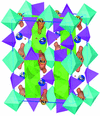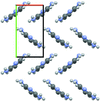issue contents
November 2017 issue

Cover illustration: Structure factors representing disordered regions of a crystal structure can be modified to account for resonant scattering, improving the chances of successful absolute structure determination. See Cooper, Flack & Watkin [Acta Cryst. (2017), C73, 845-853].
feature articles
Structure factors representing disordered regions of a crystal structure can be modified to account for resonant scattering, improving the chances of successful absolute structure determination.
research papers
Download citation


Download citation


2,6-Di-tert-butyl-4-methylphenoxide (BHT) magnesium complexes exhibit a variety of crystal structure motifs. The X-ray structures of the bi-, tri- and tetranuclear BHT–Mg complexes have been established, viz. [(BHT)(DME)Mg(μ-OBn)2Mg(THF)(BHT)], {[(BHT)(THF)Mg]2Mg(μ-OC6H4-2-Me)4} and Mg4(BHT)2(OCH2CH2NH2)6 (DME is 1,2-dimethoxyethane and THF is tetrahydrofuran), respectively. The various types of polynuclear MgxOy cores for known ArO–Mg complexes are discussed.
Download citation


Download citation


Two forms, i.e. triclinic and monoclinic, of 4-amino-5-chloro-2,6-dimethylpyrimidinium 5-chloro-2-hydroxybenzoate contain tautomeric forms of the cation, both of which exhibit quinonoid-type bond fixation, and the monoclinic form also exhibits both merohedral twinning and disorder. The ionic components in the triclinic form are linked by hydrogen bonds into finite four-ion aggregates, but those in the monoclinic form are linked into a three-dimensional framework structure.
Download citation


Download citation


A three-dimensional cadmium(II) supramolecular framework was prepared by the hydrothermal reaction between Cd(NO3)2·4H2O, 1,4-bis(pyridin-4-yl)buta-1,3-diene and adipic acid. This supramolecular architecture is formed by the interlinkage of a threefold interpenetrating diamondoid coordination network through O—H⋯O hydrogen-bonding interactions.
CCDC reference: 1570244
Download citation


Download citation


Each of three adducts of a series of dibromoperfluoroalkyl compounds, BrCF2(CF2)nCF2Br (n = 2, 4, 6), and 1,4-diazabicyclo[2.2.2]octane (DABCO) displays a one-dimensional halogen-bonded network. All three adducts exhibit N⋯Br distances less than the sum of the van der Waals radii, with one adduct showing the shortest N⋯Br halogen-bond distances yet reported between a bromoperfluorocarbon and a nitrogen base.
Download citation


Download citation


The crystal structure of a hybrid imidazolylidene/imidazolium nickel N-heterocyclic carbene (NHC) complex is reported, which can be understood as a rare example of an isolated intermediate.
CCDC reference: 1568200
Download citation


Download citation


In a new cadmium–dicyanamide (dca) complex, each CdII cation is coordinated by six nitrile N atoms from six anionic dca ligands to furnish a slightly distorted octahedral geometry. Neighbouring CdII cations are linked by dicyanamide bridges to construct a two-dimensional anionic layer coordination polymer.
CCDC reference: 1563912
Download citation


Download citation


A novel cocrystal of 3,4,5-trifluorophenylboronic acid with urea has been synthesized and structurally characterized. The preference of formation of possible supramolecular synthons has been verified by DFT calculations.
CCDC reference: 1576170
Download citation


Download citation


A new arsenate, NaCa0.77Ni2.54Al0.46(AsO4)3, was synthesized using a flux method and it appears closely related to the α-CrPO4-structure type. The proposed structural model was validated by bond-valence-sum and charge-distribution analyses.
CCDC reference: 1574601
Download citation


Download citation


The copper(II)- and gold(III)-mediated cyclizations of thiourea derivatives to substituted 2-aminobenzothiazoles are reported. The study provides mechanistic insight into the role of the metal cations in these transformations.
Download citation


Download citation


The crystal structures of the novel γ-modification of anhydrous oxalates have been determined from powder diffraction data for MnC2O4 and CdC2O4 obtained during thermal decomposition of the corresponding hydrates. The distinctive features of this modification are loose packing and low densities compared with the known α- and β-modifications of anhydrous transition metal oxalates.
Download citation


Download citation


In the isostructural tetrahedral Fe and Co complexes of the multidentate PPN ligand 2-[bis(diisopropylphosphanyl)methyl]-6-methylpyridine, the ligand adopts a bidentate P,N-coordination, whereas in the case of the octahedral Mn complex, the ligand coordinates via both P atoms to the metal centre.
Download citation


Download citation


Three rhenium(I) carbonyl-based photoCORMs have been synthesized and structurally characterized. All three complexes are highly luminescent and exhibit variable apparent CO release rates upon expousre to low-power UV light.
Download citation


Download citation


The structures of the palladium and platinum complexes of 4,4′-bis[(2,2-difluoroethoxy)methyl]-2,2′-bipyridine are isomorphous and have –C(Hα)2OC(Hβ)2CF2H side chains with H-atom donors at the α and β sites. Molecules are associated into dimers and the dimers form columns, with alternating dimers reinforced by C—H⋯Cl hydrogen bonds and C—Hβ⋯F(—C) interactions.
Download citation


Download citation


In the structure of adiponitrile, a key intermediate in the synthesis of the polyamide Nylon 66, at 100 K, the molecule adopts an exact Ci-symmetric gauche–anti–gauche conformation of the C—C—C—C skeleton about an inversion centre. The molecules are densely packed, with short contacts between the α-H and nitrile N atoms.
CCDC reference: 1579139
Download citation


Download citation


The energetic ionic salt bis(1-aminoguanidin-2-ium) 5,5′-[1,2,4,5-tetrazine-3,6-diylbis(azanediyl)]bis(1H-1,2,3,4-tetrazol-1-ide) dihydrate has a high nitrogen content and exhibits good thermal stability. The crystal structure reveals a three-dimensional network of N—H⋯N, N—H⋯O, O—H⋯N and O—H⋯O hydrogen bonds.
CCDC reference: 1513078
Download citation


Download citation


Cs3LiZn2(WO4)4 and Rb3Li2Ga(MoO4)4 represent two distinct series of filled derivatives of the cation-deficient Cs6Zn5(MoO4)8 structure with three-dimensional tetrahedral frameworks related to that of mayenite 12CaO·7Al2O3. The series of tetragonal A3Li2R(MoO4)4 compounds exhibits second harmonic generation effects compatible with that of β′-Gd2(MoO4)3.
Download citation


Download citation


Three new crystal structures of N-substituted cinnamamide derivatives, which were screened for anticonvulsant activity, are stabilized by intermolecular O—H⋯O hydrogen bonds and additionally by N—H⋯O hydrogen bonds in two of the structures. The compounds possess fragments that are considered as beneficial for anticonvulsant activity. The conformations of these compounds were analyzed in comparison with the characteristic features of the proposed pharmacophore model of the anticonvulsants active in the maximal electroshock test.
Download citation


Download citation


The influence of tautomeric forms and different coordination modes has been studied with respect to the formation of hydrogen-bonded networks in (4,4,4-trifluoro-1-phenylbutane-1,3-dionato)copper(II) moieties in the presence of pyridin-2-one, 3-hydroxypyridine and 3-hydroxypyridin-2-one.
Download citation


Download citation


A tetrazolate- and cyanide-bridged CuII–CoIII bimetallic coordination polymer is the first example of a trinodal (6,8,8)-connected three-dimensional network and is constructed from anionic [Co(CN)6]3− and cationic [(Cu1)2(tta)2]2+ and [(Cu2Cu3)(tta)3]+ units. A magnetic investigation shows antiferromagnetic interactions between the paramagnetic CuII ions.
CCDC reference: 1579476
Download citation


Download citation


In many cases, complexes of platinum and other metals have a symmetrical structure. In contrast, in the platinum(II) complex with pyridine and N-(9-anthracenylmethyl)-1,2-ethanediamine as ligands, the molecular structure is asymmetric. Only one of the two pyridine rings is π-stacked with the anthracene ligand enhancing the asymmetry.
CCDC reference: 1577766
Download citation


Download citation


An extension of the study of the coordination capability of the (4-fluorophenoxy)acetate ligand in the generation of metal complexes and, in particular, coordination polymeric supramolecular structures with the alkali metal complex salts.
Download citation


Download citation


The crystal structure of the hexgonal ternary borocarbide LiBC3 has been determined by the single-crystal method. LiBC3 represents the stucture family based on the graphene and heterographene networks.
CCDC reference: 1580572
Download citation


Download citation


Sublimation yielded a new polymorph of 2,6-diaminopyridine, a common ingredient in and a synthetic precursor to many colorants.
CCDC reference: 1580103
Download citation


Download citation


The structure of a three-component cocrystal of natural products contained extensive positional disorder in one of the molecules. The identity of the disordered molecule was established by 2D NMR and MS thereby making disorder modelling and structural refinement possible.
CCDC reference: 1580102
Download citation


Download citation


Four 3,4-dihydro-1-benzoxepin-5(2H)-one derivatives have been synthesized and the structure of 4-[3-(5-bromo-2-hydroxyphenyl)allylidene]-3,4-dihydro-1-benzoxepin-5(2H)-one was confirmed by single-crystal X-ray analysis. The inhibitory activities of these compounds against protein–tyrosine kinases (PTKs) were evaluated.
CCDC reference: 1563964
Download citation


Download citation


The structures of a dimeric nickel(II) complex and a polymeric copper(II) complex supported by 1,2,4-triazole-3-carboxylate ligands, and a dimeric cobalt(III) complex supported by 3-amino-1,2,4-triazole-5-carboxylate ligands are reported.
Download citation


Download citation


Two coordination polymers with distinct structures have been prepared under hydrothermal conditions, based on mixtures of benzene-1,3,5-tricarboxylic acid and trans-1-(pyridin-3-yl)-2-(pyridin-4-yl)ethene, together with two different d10 metal ions. Both compounds exhibit good photocatalytic properties in the decomposition of the organic dye contaminant of rhodamine B.
Download citation


Download citation


Copper complexes ligated by benzyldipicolylamine (BDPA) are described. Intermolecular O—H⋯O(triflate), O—H⋯O(tetrahydrofuran), C—H⋯F(triflate) and C—H⋯O(triflate) hydrogen bonds stabilize the crystal lattice of both structures.
Download citation


Download citation


Three new platinum(II) complexes of the type [PtCl(R-OQ)(Eug)], containing eugenol (Eug) and a quinolin-8-ol derivative (R-OQ), show promising in vitro cytotoxicity on four human cancer cell lines.


 journal menu
journal menu















































